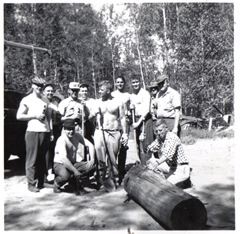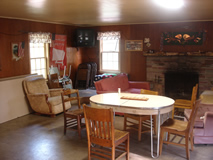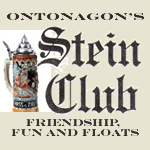
Steins in the Stein Club House

Carl Domitrovich

Steins Club 1957

Building the Club

Inside the Club

Original Club Members
Club Meetings, Parties and Activities
Wednesday, June 26, 2007
Stein Club Sundays: The Regular Meetings
The members met officially every second Sunday of the month. Although the group was mainly a social club, it is a registered non-profit, complete with by-laws, an officer and a treasury. Mick Hoefferle is the club's only officer, the treasurer, and has been for the last twenty years. Any person who suggests that the club should have a formal meeting is automatically president for that meeting. Mick jokes, “We tried installing a secretary, but when it was finally time to take notes, the guys had too much beer to write legibly.” Therefore, meeting notes were only kept when necessary and for mostly practical matters. The following list highlights some of the issues documented in the meeting notes notebook:
1. Clubhouse maintenance: purchasing fire insurance, replacing the roof, fixing windows, building a new chimney, acquiring a lawn mower, buying a freezer and paying taxes
2. Club improvements: purchasing and installing new dart board
3. Party announcements: Women's party, Halloween, Christmas, Spring Break, Pig Roasts, Garden Feed, Harvest Dinner, Birthdays
4. Guidelines for smooth party organization: appoint a booze committee and divide up jobs into music, decoration and invites
5. Miscellaneous: Motions to have Labor Day floats and vote on themes, motion to sell Mrs. Hoefferle a chair for a keg of beer
Mick Hoefferle describes the organizational structure of the club:
“Originally, it was designed for twenty four members -- two members for each month. Your partner and yourself had one month a year where you would cook and clean up. The group was divided into three party groups. One group would put on the party, one would clean up and the third group enjoyed itself. On Stein Club Sunday, we'd go out and someone would be putting on the meal and cleaning up. They would provide beer and cigarettes, whiskey and we would go out and play cards, drink beer, throw horseshoes, chew the rag, and we would discuss with a lot of energy the current politics that were going on. We would offer advice to each other on how to carry on our lives and raise our families. We would make non-binding political decisions like, ‘To hell with the Republicans' or ‘To hell with the Democrats' or ‘We don't want the Mackinaw Bridge' or stuff like that. Or ‘We are against the new cigarette tax' or ‘Beer is getting too expensive.' Beer is still the best value in the course of my lifetime. It is more cost effective to drink beer than anything else.
A meeting would last all day Sunday. Sometimes it would start on Friday or Saturday, but mostly just on Sunday. What would happen is the village dump used to be out there, and people would haul their garbage out past the Stein Club, we'd always have cold beer. Most people brought their garbage out on Saturday, and we'd often start cooking on Saturday, getting it warmed up in the winter time. So we'd stop in and chew the rag, drink a beer. Sometimes ten or fifteen people would show up. On Sunday, we'd have a lunch, beer, then supper. Years ago, I never got home from the Stein Club until 11, 12, 1, 2 o'clock. Now it's pretty early, six or seven.”
For the first few meetings, the meals served on Stein Club Sundays were nothing spectacular -- most likely, beans and baloney. Then, a few members made something a little tastier, and other men followed with even better cuisine, upping the ante with pig roasts, grilled corn on the cob, and delicious stews. If the club's chefs didn't prepare well enough for the likings of the club, they were light-heartedly chastised as Carl illustrates in the following quip:
“ One time, I think Danny Lutz, all he had to feed us was pasties. He thought they were already warm but he brought em up here – cold pasties. Boy, he never heard the end of it. We even nailed one up on the wall! Just as a reminder for no one to do it again.”
The Club's Parties and Activities
As a non-profit organization, the Stein Club sponsored many charitable, civic and social events. The members played softball or basketball games against other men's groups in Ontonagon. Open to the public, many of the games served as fundraisers, mainly to support their own club but also for charitable causes. During the 1959 Labor Festival, the Club sponsored the speed boat races, and the members' wives “had charge of the concessions on the river bank” (Herald, Sept. 10 Vol 78 #32). In 1960, during Labor Day weekend, the Club challenged the Local 354 Hussman to a game of donkey basketball, where players literally played the game riding on live donkeys. According to the local newspaper, “No one could keep an accurate score of the game, but all agreed that the trained donkeys emerged as the winners” (Sept 8, Vol 79 #32, 1960).
The Clubhouse became host to gambling/casino nights, Christmas, Spring and Winter “Frolics”. The frolics/parties were the club's main and most frequently held programs. The all-male organization invited women, friends, and family to the parties that they threw, and those parties were big, celebratory, and memorable. For good or ill, the parties in Upper Michigan, usually involve beer in one way or another. Mick offers that the name Stein Club translates into “Drink Beer”. Carl claims, “Most times, a keg wouldn't be enough. We'd have to go for a second keg or an extra case of beer.”
Along with food, drink and camaraderie, the Stein Club Band played at every party. Joe and Rudy Stimac, brothers who grew up on a farm just down the road from the Stein Club, played accordions, guitars or banjos, drums, bells, washboards, and anything that made noise, but the leader of this homegrown entertainment was, unquestionably, Hank Thompson. A local legend/local character, Hank played his accordion and sang anywhere people would tolerate him. He even led the kiddie parade with his accordion every year during the Labor Day celebration. Carl says this about his friend, “Hank knew songs… he had more songs in his head than in the book. Hank would come in (the clubhouse), he wouldn't be half-way across that floor and he'd stop and had a joke for us. He had everyone laughing when he was around here.” Mick Hoefferle said that “Hank couldn't read a note of music. The more he drank the crazier he got. Everyone in town knew who Hank Thomposn was – he was just a piece of work. He was about four feet tall. He'd been all over, busted and poor all his life.” Mick was so impressed with Hank that he wrote his own folk song about him, called "Jack of All Trades."
Mick, a fabulous story teller in his own right, recounts the tone of the parties:
“Oh Jeese. Well it was always a musical event. Hank Thompson would drive out on his tractor with his squeeze box in the back. That was a lot of fun. Our parties were great. We'd always end our parties by throwing the empty half-barrel out the door. Vooooomph. Out the door goes the half barrel. “It's over folks!” It's just been a lot of fun. We used to race cars out on the road out in front. Randy Schober and Dave Menzmer were the last two to race out there. We'd have horshoe events, pig roasts. The harvest parties were great. The wives' party, we would dress up in waiters' outfits and wait on the ladies. They would put on their nicest frocks. And they'd all turned out the same. After everybody started off like a bunch of stuffed shirts and after adding copious quantities of alcohol, everyone would loosen up and dance. For years, we'd have big canisters of cornmeal, and we'd throw it on the floor when everything got sticky and beer-y and hard dancing. We'd throw cornmeal all over everything, so we'd slide a little better. Dance. And we always had lots of music. It was mostly live music by the Stimac brothers and Hank. Rudy Stimac loved music, all of it. Not just schottische or old Croatian shit. And it was really interesting listening to the Beatles with a Croatian tilt to it. I can remember “Yesterday” on the squeeze box. He had kind of a nasal drawl. Oh it was good.”
